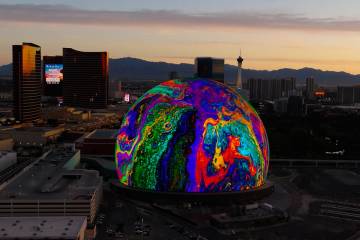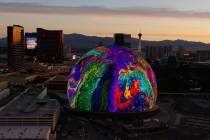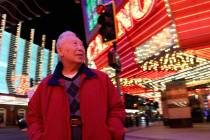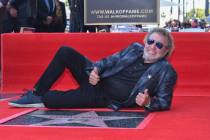Staycation lets you explore Vegas’ past from humble beginnings to bling
When you think of holiday travel, certain images probably pop into your head: crowded airports, clogged freeways, frenzied schedules, frazzled nerves.
But a more leisurely journey awaits adventurous Southern Nevadans this holiday season: a trip back in time.
Make that multiple trips, because a trio of museum exhibits — one of them at a Strip casino — explore various eras in local history, from the Las Vegas town site’s earliest days to the showbiz dazzle of Neon Nirvana.
And a photography display spans those eras, focusing on Nevada’s timeless landscape — and the water challenges affecting its past, present and future.
So don’t bother to pack. Just bring your curiosity as you venture forth on a memorable Vegas staycation.
First stop: the Springs Preserve’s “Nevada Reflections.”
Subtitled “The Silver State in Black and White,” photographer Cody Brothers’ stark images range from Utah’s Dead Horse Point to California’s Topock Marsh, tracing the path of the Colorado River to, and from, Southern Nevada.
But Brothers shot most of the photos much closer to home, illustrating Southern Nevada landscapes affected by water — including “how the (water) levels have dropped off” in Lake Mead, Brothers says.
Based in Santa Fe, N.M., Brothers shoots with infrared black-and-white film, employing two panoramic cameras and a third, complete with old-fashioned bellows, that produces 4-by-5-inch negatives.
“I’m an old-school film guy — that’s why I can blow the images up so big,” enabling “the viewer to have a one-to-one relationship” with the photographs and “see what I was seeing.”
Shooting with infrared film “makes all the foliage and greenery white and glowing,” Brothers says. That in turn “puts an emphasis on it — to show there is water, there is life, and it’s important.”
Brothers was commissioned to shoot the “Nevada Reflections” images, but they also fit thematically into his decadelong focus on “the abandonment of the West,” he says, “to kind of make the West look the way it did — before we came and ruined it all.”
Our next stop, next door to the Springs Preserve at the Nevada State Museum, introduces the daughter of a someone who was all too happy to exploit the West’s resources for maximum financial gain: Clark County’s namesake, Sen. William A. Clark of Montana, whose 1905 auction of 1,500 lots in “Clark’s Las Vegas Townsite” signaled the birth of Las Vegas.
Clark’s wasn’t the first Las Vegas town site, according to museum director Dennis McBride.
In 1902, J.T. McWilliams had laid out another town site (west of Clark’s eventual site) and “was all raring to go,” McBride notes, “when here comes William A. Clark,” who “has the money, he has the railroad, he has the political clout — and all the water rights. And he left poor J.T. out in the cold.”
Copper king Clark was one of the wealthiest men of America’s 19th-century Gilded Age. But it’s his daughter, Huguette, who inspires the museum’s current “Empty Mansions” exhibit.
Subtitled “The Mysterious Life of Huguette Clark and the Spending of a Great American Fortune” — echoing the book that inspired it, by Bill Dedman and Paul Clark Newell Jr. — the exhibit includes photos of the senator’s brief, but fateful, Las Vegas foray.
Its main focus, however, is Huguette, a reclusive artist who lived to 104 — and spent the last two decades of her life in New York hospitals while her Connecticut and California estates sat empty.
Much earlier in her life, Huguette visited Reno, then America’s divorce capital, to end her short-lived marriage, leading to screaming newspaper headlines (“RENO AGOG OVER CLARK KIN’S MOVE,” one reads) featured in the museum exhibit.
Huguette Clark, who died in 2011, was back in the news this September, when a deal was reached to divide what was left of her $300 million estate among the 19 relatives who challenged her will, which left them nothing.
The exhibit helps “to remind people of where Clark County came from,” McBride says, and touches on “the strange things connected with so much of the history of Las Vegas.”
Clark’s Los Angeles, San Pedro and Salt Lake Railroad brought residents to the new town of Las Vegas.
Some of them lived in cottages built by the railroad’s subsidiary, the Las Vegas Land and Water Co. — and one of those cottages, now restored, has joined other historic homes and buildings on Heritage Street at the Clark County Museum in Henderson.
One of 10 that still exist (out of 64 built from 1909 to 1911), the concrete cottage was originally at 521 S. Third St. in Las Vegas, according to museum administrator Mark Hall-Patton.
The 768-square-foot, two-bedroom cottage may have been “mass housing,” but “it was a very nice structure,” Hall-Patton says. “For $18 a month, you could rent one of these and live quite comfortably.”
The cottages —and its Heritage Street neighbors — provide “a chance to place your knowledge in some context,” he says. “It is a way of understanding, on a very basic level, that this is where we came from.”
As for what Las Vegas became — at least in the eyes of the world — we’re off to the Strip, where The Cosmopolitan of Las Vegas hosts the pop-up museum exhibit “Too Much of a Good Thing Is Wonderful: Liberace and the Art of Costume.”
On the casino floor, a rhinestone-studded Duesenberg roadster gets visitors in the mood for Liberace’s signature brand of bling.
Inside the display, a rhinestone-studded Baldwin grand piano faces the entrance, while video monitors show Liberace in action and display pithy quotes from the longtime Strip headliner, including the telltale “I don’t dress this way to go unnoticed.”
At the heart of the exhibit: 15 mannequins decked out in the kind of eye-popping excess that accompanied Liberace’s four-decade showroom reign.
Beneath the shimmering bugle beads, sequins and rhinestones, the garments may be humble polyester gabardine. But they’re utterly transformed into fantastical costumes suggesting everyone (and everything) from King Nepture to Liberace’s piano itself. (Two outfits suggest the latter; one with silver-and-black sequined piano keys on tuxedo lapels and cuffs, the other encrusted in crystal rhinestones and weighing 80 pounds.)
The elaborate stage attire signals Liberace’s “absolute love (of) and sense of entitlement to decadence,” according to curator Deirdre Clemente, assistant professor of history at the University of Nevada, Las Vegas — who recently served as historical consultant for another costume-centric project, director Baz Luhrmann’s big-screen “Great Gatsby” adaptation.
Beyond Liberace’s personal flair, however, his costumes also reflect “the context of Las Vegas,” Clemente says. And “what it says about Las Vegas is, there’s never too much of something. You can’t overdo.”
Many of the costumes (along with the piano) will be familiar to anyone who visited the Liberace Museum before it closed in 2010 after 31 years.
Having Liberace’s costumes back on the Strip “means a lot to the history of our community,” says Brian Paco Alvarez, chairman of the Liberace Foundation, which is presenting the exhibit. “The community was so focused on the museum, they thought it was all gone.”
Contact reporter Carol Cling at ccling@reviewjournal.com or 702-383-0272.
Preview
Here’s where, and when, to explore these "Vegas Staycation" exhibits:
■ "Nevada Reflections: The Silver State in Black and White" — 10 a.m. to 4 p.m. daily (except Christmas Day) through Jan. 20 in the Big Springs Gallery at the Springs Preserve, 333 S. Valley View Blvd. Admission: $4.95-$9.95 for Nevada residents, $10.95-$18.95 general. Information: 702-822-7700.
■ "Empty Mansions: The Mysterious Story of the Clark Heiress Linked to Las Vegas" — 10 a.m. to 4 p.m. Thursdays-Mondays through December at the Nevada State Museum, 309 S. Valley View Blvd. Admission: adults $9.95, children 17 and younger free, includes access to Springs Preserve. Information: 702-486-5205.
■ Heritage Street — 9 a.m.-4 p.m. daily (except Christmas and New Year’s Day), Clark County Museum, 1830 S. Boulder Highway, Henderson. Admission: $1-$2. Information: 702-455-7955.
■ "Too Much of a Good Thing Is Wonderful: Liberace and the Art of Costume" — 3-10 p.m. daily through Feb. 28 at The Cosmopolitan of Las Vegas, 3708 Las Vegas Blvd. South. Free admission; donations to the Liberace Foundation’s scholarship fund accepted. Information: 702-698-7640.





































